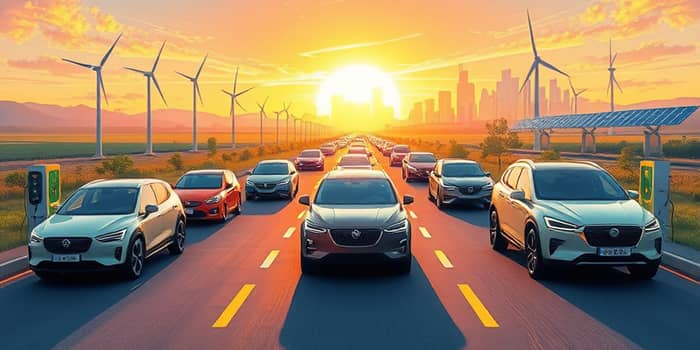
The year 2025 marks a pivotal moment for the automotive sector as consumers worldwide embrace electric vehicles at unprecedented rates. Fueled by technological breakthroughs, evolving policy frameworks, and heightened environmental awareness, the shift is redefining the industry’s trajectory. Manufacturers, policymakers, and drivers are converging on a shared vision for cleaner, more efficient transportation.
Early data reveal that a remarkable twenty-five percent increase in battery-electric and plug-in hybrid sales has propelled global EV deliveries to nearly 22 million units. This level of demand eclipses previous benchmarks and underscores automakers’ agility in scaling production. In May alone, more than 1.6 million electric cars found new owners, bringing the year-to-date total to 7.2 million, a 28 percent jump over last year.
The global landscape, however, is not uniform. China continues to lead with 4.4 million EVs sold year-to-date, representing a 33 percent rise. Europe follows at 1.6 million units (27 percent growth), while North America trails at 0.7 million (3 percent growth). Meanwhile, other regions collectively achieved 0.6 million sales, marking a 36 percent increase in markets less frequently highlighted.
In China, the electric revolution has reached a tipping point. Consumers benefit from a combination of government subsidies, extensive charging networks, and expanding entry-level EV options. These factors have allowed electric cars to capture over half of all new vehicle sales in the country, challenging established norms and inspiring global players to adapt their strategies.
Europe’s journey is similarly remarkable. Nations such as Spain and Italy have witnessed surges in EV registrations following the introduction of fresh tax incentives and rebates. Automotive brands are capitalizing on this momentum, unveiling new models tailored to local tastes. Germany and France remain key battlegrounds, driving robust competition and accelerated innovation.
North America’s path has encountered headwinds. A reduction in federal and state incentives, coupled with regulatory rollbacks, has slowed growth to just 3 percent. Uncertain policy landscape in the US has tempered consumer enthusiasm, yet industry leaders like Tesla maintain dominance, registering more than 46,000 units sold in May alone.
The competitive field of electric vehicles is expanding. Tesla retains its top position globally and within the used market, thanks to a strong brand presence and loyal customer base. However, legacy automakers and new entrants alike are making bold moves. General Motors, the Hyundai Motor Group, Ford, and Honda are accelerating their electric agendas, unveiling compelling SUVs, sedans, and crossovers.
These figures reflect the early momentum of diverse models that cater to a broader array of buyer preferences, from performance sedans to electric pickup trucks.
Consumer motivations for going electric have crystallized around several core themes:
These factors converge to make electrification not only an ecological imperative but also a compelling economic choice for many households.
The pre-owned electric vehicle sector has emerged as a vital bridge to broader adoption. In May 2025, used EV sales climbed 32.1 percent year-over-year, driven by affordability and improved consumer confidence. Historically dominated by Tesla models, the segment is now diversifying as more brands enter the resale ecosystem.
As warranties extend and battery longevity becomes better understood, buyers are gaining trust in purchasing lightly used EVs. This trend also offers a pathway for price-sensitive consumers to experience electric mobility without paying a premium for new technology.
Despite widespread optimism, hurdles remain. Market fluctuations in raw material prices can affect vehicle production costs, while supply chain disruptions still pose risks. Moreover, regulatory changes—especially in North America—introduce uncertainty that can delay investments and slow consumer adoption.
Automakers must remain agile, adjusting inventory strategies and pricing to align with evolving conditions. Strategic partnerships with charging networks and renewable energy providers will be crucial to overcoming these obstacles.
Electrification is no longer confined to passenger cars. Commercial sectors are following suit, with electric buses, delivery vans, and two/three-wheeled vehicles achieving high adoption rates in several countries. Battery production capacity is expected to double by the end of 2025, suggesting supply-side constraints will ease in the near future.
surging adoption in regional markets signals that the transition extends beyond personal mobility. Fleets worldwide are exploring electric options to meet sustainability goals and reduce operational costs. This momentum fosters a larger ecosystem that includes vehicle-to-grid technologies, energy storage applications, and smart charging solutions.
Analysts forecast that one in four new cars sold globally in 2025 will be electric, a proportion set to rise as technology matures and policies tighten. Continued investment in charging infrastructure, battery research, and consumer education will further accelerate this trend.
For manufacturers, the imperative is clear: deliver value-driven electric offerings that align with diverse consumer needs. For consumers, the path to electrification is increasingly accessible, offering long-term savings and a reduced carbon footprint.
As the automotive industry rewrites its future, the rise of electric vehicles stands as a testament to collective innovation, environmental stewardship, and economic pragmatism. The journey is far from over, but the roads ahead are illuminated by the promise of a cleaner, more sustainable era of transportation.
References













